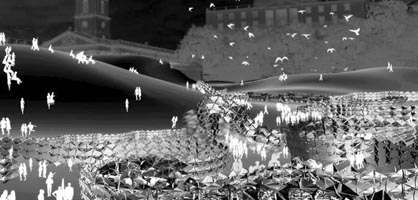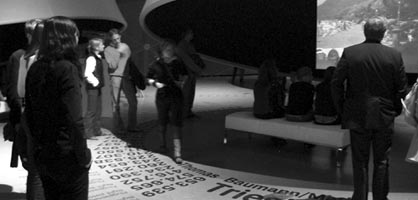|
|
| home > extended play |
| The
Philosophy of Digital Architecture: The FEIDAD Award Yu-Tung Liu |
||||
| The
Far Eastern International Digital Design Award (The Feidad Award) was
conferred for the first time in 2000, its aim being to encourage and
honour innovative design created with the aid of digital media. In 2005,
the jury which comprised Christian Bruun (Quantum Film), Greg Lynn (Greg
Lynn FORM), Jacob van Rijs (MVRDV), Gerhard Schmitt (Swiss Federal Institute
of Technology), Birger Sevaldson (Ocean North), and other distinguished
architects, awarded the prize for the sixth time. The 2005 Feidad award
includes 126 submissions by architects, students and designers from
26 different countries, exploring digital concepts such as computing,
information, electronic media, hyper-, virtual-, and cyberspace in order
to help define and discuss future space and architecture in the digital
age. Outstanding award for the 2005 edition of Feidad was conferred
to ReD | Research +
Design (Marta Male-Alemany, Jose Pedro Sousa), whose project had
already been presented on the pages of ARCH'IT and whose work was featured
in "The Storytellers" exhibit, part of the BEYOND MEDIA festival
in Florence. The Design Merit Award was given to Evan
Douglis, BASE4,
R&Sie(n) + D,
and Fabio Schillaci. ARCH'IT presents here the FEIDAD through the words
of Yu-Tung Liu, chairman of the Award |
||||
| THE
EMERGENCE OF DIGITAL ARCHITECTURE. In the year of 2000, the end of the
20th century and the beginning of the 21st century, the applications
of computer had already changed the design method, especially the technology
like the virtual reality, CAD/CAM technology, and Internet. Through
the computer, many famous architects, for instance Frank Gehry and Peter
Eisenman, had designed various amazing spaces. Many of the architectural
elements had been redefined, such as function, form, volume and space.
This new type of architecture produced by the combination of new architectural
efforts and digital technology is generally called digital architecture.
After several years of development, the debate of the computerization
has been shifted from the more technical issues into the issues related
to the digitality of architecture, such as "Is this a temporary
phenomenon or a permanent revolution?" "Will this tool hurt
the architecture since we're not familiar with it?" "Are we
ready for the new revolution?" "What's digital architecture?" Triggered by these new developments in architecture, I proposed an international award on digital architecture to Mr. Douglas Tong Hsu, the Chairman of Far East Group in Taiwan, who has long been interested in the future of architecture not only in Taiwan but in the whole world. With Mr. Hsu's full support, the Far Eastern International Digital Architecture Award (FEIDAD) will be celebrating its fifth anniversary this year. As now I retrospect, the major concepts behind the establishment of this award could be recapitulated as follows. THE DEFINITION OF DIGITAL ARCHITECTURE: NEW TOOL? NEW THEORY? NEW AGE? NEW REVOLUTION? Digital architecture might be just a new tool. If the digital technology does not influence the design thinking, design method and spatial theory, then it can be treated as merely a new tool. Even though, the digital technology will be another breakthrough as a tool, much more powerful than the drafting invented in the Greek time or the modeling in the Renaissance.  Digital architecture might be also a new theory. If it can be used to assist the design thinking process by internet-aided design and web-based design, the design method based on the Bauhaus pedagogy will be redefined. In the same time, the design theory from the Renaissance will be also greatly changed by the computer-aided design and design with computer. In addition, if our cyberspace and networked space experience can ultimately influence our spatial concepts in the physical world, following the massy Egyptian space, geometric Greek space, mystic Gothic space, dynamic Baroque space, modernism space, there will be a brand new spatial theory, so called digitalism. On the other hand, if the design method, thinking pattern and spatial theory are all changed by the digital architecture, digital architecture will be more than a theory. The digital architecture might thus form a new age if it is considered to have an overall impact on architecture. We should pay attention because if the digital architecture really forms an age, it will influence not only on architecture, but also the value system (Why it is good) and new aesthetics (what is beauty). Finally, digital architecture can be defined as a revolution. Every revolution changes human history and life style: fishing and hunting revolution, agricultural revolution and industrial revolution. Since architecture is only a small part of the social evolution. We can only wait to see what drastic socio-cultural changes will emerge in the digital age.  In addition to these possibilities, we can also define the digital architecture by its duration. The duration generally lasts for a few months for a new tool, 10 to 30 years for a new theory, hundreds to thousands of years for a revolution. Therefore, if the digitality of architecture can last a few years, it might be regarded as a new tool; if more than 10 years, it might be considered as a new theory; if more than 30 years, it might be seen as a new age; if more than even hundred years, it might be defined as revolution. In an attempt to figure out these possibilities of architecture in human civilization, in the year of 2000, it was our common goal to launch the FEIDAD Award, the Far East International Digital Architectural Design Award. The aim of the Award is to seek projects exploring digital concepts such as computing, information, electronic media, hyper, virtual, and cyberspace in order to help define and discuss future spaces and architecture in the digital age. THE GAPS IN DIGITAL ARCHITECTURE. It is not easy to predict the future of the digital architecture, although, it is still progressing with the full speed. There are still gaps between the architectural education, society culture, and digital architecture.  The first is the gap between the professional and non-professional. As I mentioned previously, the revolution generally causes controversy. Even though many people only use computer to type and e-mail, they don't hesitate to criticize and question the digital architecture. In 1992, while I was attending a meeting in Boston, some people are still debating whether the computer can think independently, without knowing that the Deep Blue has already defeated the world chess champion. The second is the gap between two exiting generation and digital generation. We define the generation every 10 years. It's not easy for the different generations to communicate with each other. The generation gap between the existing generation and the digital generation can be easily seen in the debate of architectural design process, presentation, space, volume, concept and aesthetics (a Taiwanese architectural student almost got flunk for using the computation presentation instead of tradition drawings and models). The gaps exist everywhere in the world. For instance, the digital generation uses computer to white, thinking the traditional writing time-consuming, while the other generation criticizes the writing in the e-mail as "the writing without quality". This kind of criticism sounds familiar, we can trace it back to seventy years ago, while the Chinese modern literature replaces the classical literature. The Renaissance people who write in quill and brown ink may have the same criticism towards the stationery today. The third is the gap between the architectural and non-architectural field. Focusing more on the arts, history and culture, architecture always reacts slowly for the technology revolution. For instance, the communication has been totally digitalized, the architects still merely use metal and glass to express the avant-guard architecture, without digitalizing the design process. Meanwhile, the architectural education hardly puts any effort to keep up with the rapid change of the digital technology. It's possible that the traditional architectural education is still based on the philosophical, social, historical and psychological theory.  The last is the gap between digital technology and human science. Emphasizing its philosophical, historical, social and cultural context, architecture is always the essential part of the human science. Many people still worry the overusing of computers. However, they forget that the new technology always causes new culture, like the printing and the Eiffel Tower. (When the Eiffel Tower was built, there was even the traditional artist who committed suicide to protest.) I sincerely believe, the computation will enhance the cultural development a lot, same as the architecture. From the year 2000 to 2005, in the six FEIDAD awards, there are 757 architects/designers/students/groups from 47 countries submitted their explorations and 98 jurors from 27 countries participated the review processes. They are all trying very hard to bridge the gaps through taking part this award. DEFINING ARCHITECTURE IN THE DIGITAL AGE. In the architectural and arts history, new vision is heavily criticized by the contemporary society. Only few of these new visions can be confirmed and recognized as master pieces. The vision of digital architecture also needs both the personal creativity and the social appreciation. Many people are making their most efforts to define digital architecture. They are writing the history of digital architecture. The intention of this FEIDAD Award, playing the role of social appreciation, is to gather the creative wisdom of the young architects and designers in this new, critical period. All these define the future history of architecture. Yu-Tung Liu Graduate Institute of Architecture, NCTU, Taiwan Chairman, the FEIDAD Award |
[13may2006] | |||
| REFERENCES: Liu, Y. T. (ed). Demonstrating Digital Architecture: 5th FEIDAD Award. Basel, Switzerland: Birkhäuser, 2005. Liu, Y. T. (ed). Diversifying Digital Architecture: 2003 FEIDAD Award. Basel, Switzerland: Birkhäuser, 2004. Liu, Y. T. (ed). Developing Digital Architecture: 2002 FEIDAD Award. Basel, Switzerland: Birkhäuser, 2003. Liu, Y. T. (ed). Defining Digital Architecture: 2001 FEIDAD Award. Basel, Switzerland: Birkhäuser, 2002. Liu, Y. T. (ed). Defining Digital Architecture: 2000 FEIDAD Award. Taipei: Dialogue, 2001. |
||||
| > FEIDAD AWARD | ||||
| Per
qualsiasi comunicazione laboratorio
|